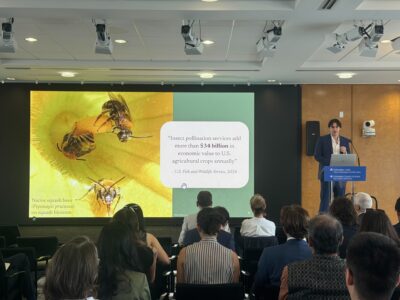
Having worked as the assistant editor of Sanctuary Asia, an Indian wildlife magazine, co-founded the 2041 Antarctic Youth Ambassador Programme, and volunteered with the Indian Youth Climate Network, current MPA in Environmental Science and Policy student and Fulbright scholar Swati Hingorani (’14) has always had a passion for environmental issues. As she looks forward to her graduation from the program, Swati anticipates that her experiences as an ESP student will help her return to these positions with a new perspective.
1. What drew you to the Master of Public Administration in Environmental Science and Policy program?
Although I had been working in the environmental field for a few years, I was doing so without a formal education in science. When I was awarded a Fulbright Nehru scholarship to attend graduate school in the U.S., I chose the MPA-ESP program for its unique combination of science and policy and its strong focus on identifying practical solutions to environmental issues.
2. What were you doing before you started the program?
I spent the last five years as the assistant editor of Sanctuary Asia, a wildlife magazine in India. In addition to my editorial duties, I piloted an India-Pakistan peace initiative on the Siachen Glacier with Bittu Sahgal, Editor, Sanctuary Asia, organized a series of policy discussions on tiger conservation and worked on our corporate sustainability initiative and children’s environment education program. We also worked on our corporate sustainability initiative and children’s environment education program. Around the same time, I co-founded and ran the 2041 Antarctic Youth Ambassador Programme, an initiative to involve young people in the protection of Antarctica. As a volunteer with the Indian Youth Climate Network, I attended the UN climate negotiations in 2009 as an Indian youth delegate, coordinated the delegation for the 2010 negotiations, organized the first South Asian Youth Summit on Climate Change and a 2009 Indian Youth Summit on Climate Change.
3. What area of environmental policy and management are you most interested in?
My interest lies in wildlife conservation. I hope to work with forest departments and communities in India to secure our vanishing wildernesses.
4. What skills and tools do you hope to acquire through the program?
The summer semester gave me a solid grasp of the fundamentals of environmental science, which is exactly what I wanted from the program, and I feel better equipped to design policies that are rooted in science.
5. What is your favorite class in the MPA-ESP program so far, and why?
Definitely our Principles of Ecology class! It was incredible to learn from a dynamic and experienced professor like Dr. Palmer, and I particularly loved the field trips, because they got us outdoors and in touch with the environmental issues we will be tackling once we graduate.
6. How has collaborating with your fellow students in class projects benefited you professionally and personally?
There is so much diversity in our class in terms of backgrounds and experience, and it has been incredible to learn from my cohort. One of the strengths of the way the program is designed is that it encourages group work and learning from your peers. This was one of the things I loved most about the summer semester – it was very intense and challenging, but we came together beautifully as a class, supported one another and developed lasting relationships. In our fall and spring semesters we can take classes at other schools at Columbia, and I’ve been doing so at the Department of Ecology, Evolution and Environmental Biology, and it has been wonderful to engage with people outside SIPA.
7. Beyond the classroom, what, if any, extracurricular sustainability-related activities have you engaged in with your fellow Environmental Science and Policy students?
I am going to attend the NCSE‘s 14th National Conference and Global Forum on Science, Policy, and the Environment: Building Climate Solutions in Washington with two of my peers at the end of January.
8. How do you intend to utilize your degree from the MPA-ESP program to further your career?
I will be returning to my job at Sanctuary Asia after the program as well as continuing with the 2041 Antarctic Youth Ambassador Program. I can already see a change in how I approach my work based on everything we have learned in the past two semesters, particularly our workshop that gave me a unique insight into policy design and management.
Students in the MPA in Environmental Science and Policy program enroll in a year-long, 54-credit program offered at Columbia University’s School of International and Public Affairs, in partnership with the Earth Institute. Throughout this one-year program, students are immersed in courses that combine Columbia University’s hands-on approach to teaching public policy and administration with pioneering thinking about the environment. During the summer semester, students learn the fundamentals of environmental science, while in the fall and spring semesters, they focus on the policy and economics necessary to becoming successful environmental analysts and managers. Visit our website to learn more about the program.



